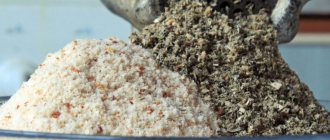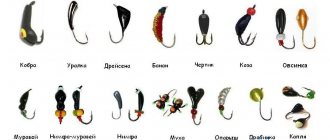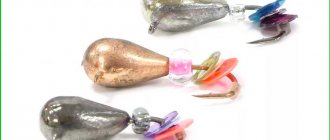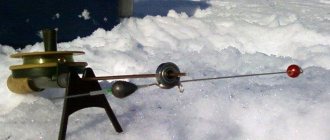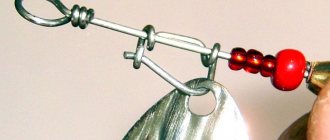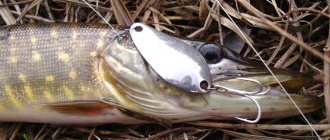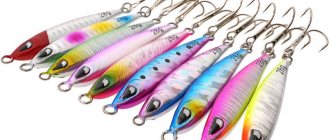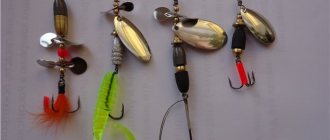On the shelves of fishing stores there are many options for reelless baits for every taste, but some prefer to make reelless ones with their own hands. Some people do this to save money, others are simply interested in the process.
If you have experience, you can make nozzle-free jigs with your own hands, spending only a few minutes on one nozzle.
Such a bait will be in no way inferior to purchased models or may even surpass them. It’s not at all difficult to make catchy baits yourself at home or even open an impromptu mini-production to supply baits to familiar fishermen.
Pros of DIY
By making reelless baits yourself, you can save on bait. Personally made jigs are practically free. Another plus is that fishing with homemade baits is a special pleasure.
When making jigs, you can copy ready-made jigs or invent your own, experimenting with materials, shapes and sizes and selecting the most catchy design options. It’s better to start with copying to get first experience and get better at it. Then, if desired, you can move on to developing your own baits.
Common forms of mothless moths
Baitless baits come in many different shapes and sizes. But they are all similar in that they closely resemble insects and crustaceans, which is why most of them have corresponding names. Below are the most catchy reelless jigs in rating order.
- “Uralka” can have different sizes, weights and is intended for fishing with or without bait. The most common jig used for fishing for any type of fish.
- “Devil” is a drop-shaped jig-nymph with three hooks in the lower part. Can be supplemented with colored beads, beads, pieces of cambric.
- “Curved devil” is a variety of “devil” with a curved body, designed for fishing in still water and weak currents.
- “Composite devil” is a movable jig-nymph, consisting of two parts for catching large fish at great depths and in currents.
- “Goat” is a classic lightweight (0.3-0.8 g) rewinder with two hooks, reminiscent of a goat’s head.
- “Ant” is a small jig with one hook that resembles the body of an ant.
- “Bug” is a small fancy egg-shaped mothless fish with three hooks.
- “Dreissena” is a popular nymph jig for perch and roach with one hook and bead rigging.
- “Klop” is a low-frequency jig weighing 0.5 g for deep bream fishing.
- “Moth” is an ultra-light mothless (up to 0.1 g), shaped like a bloodworm.
Manufacturing methods
If you want to make homemade rewinders, the first thing you need to do is decide on a method.
Casting
This method can be called both the easiest and the most difficult. The difficulty is that first you need to make a good mold, and this is quite difficult to do. It is best made from aluminum. You can buy such a form in a store or order it from a familiar locksmith.
Another option is to make it from gypsum. But plaster forms are short-lived. Although many fishermen successfully use them. To make the gypsum mold stronger, the solution must be mixed with a 2-3% solution of borax, 5-6% sugar or 3-5% solution of wood glue.
You can also make a mold from PVA glue. To do this, you need to add talc or kaolin to it. This form must be dried for several days.
Sawing
You can first cut a blank from a piece of metal, and then give it its final shape using a file and a needle file. This method takes much longer than casting, but it does not require a special mold.
Winding
In this case, it is necessary to wind the wire around the shank of the hook and then cover it with solder. The disadvantage of such reelless baits is that they weigh less than solid baits. Namely, the mass is often the decisive factor in order to perform the correct wiring.
Soldering
In this case, you need to make the base of the future coilless coil from foil, and then fill it with solder. Tin is usually used, although lead bait can be made in the same way. The disadvantage of tin reelless moths is their low weight.
Materials
Most often, rewinders at home are made from lead. This metal melts easily and is poured into a mold; sawing or filing it is also not difficult. Lead is a heavy metal, and mothballs made from it have a decent mass. Rewinders are less commonly made from tin.
The wire material from which the body of the jig is wound can be of any kind. If foil is used to make jigs, it can also be made of different metals. You can choose it by color - yellow or silver.
Pay special attention to the hook. It must be of high quality, sharp and thin. Only then will the reelless fish catch fish well. The hook must be proportionate to the body of the bait. At first, be guided by ready-made commercial jigs to choose the right one.
Characteristics
Manufacturers of fishing tackle offer a large number of Nymph jigs with different characteristics. These baits differ from each other not only in appearance, size and shape, but can also be made of different materials. In addition, Nymph jigs are painted in different colors and are often used in combination with canopies that are located on the hook.
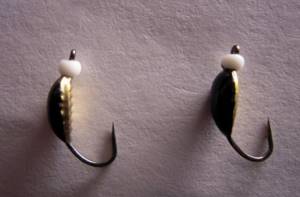
Material
The best material, ideal for making the Nymph jig, is tungsten. The tackle made from it is very durable and has a lot of weight with a small volume, which ensures its rapid immersion to a depth of up to 5 m even in the presence of a strong current. It is almost impossible to make a tungsten “Nymph” yourself, since the material is difficult to melt, so such bait is bought in specialized stores.
The second most popular material for making the Nymph jig is lead. With this gear you can fish in calm water at shallow depths (2–3 m). Lead bait is characterized by slower immersion, but it can be made independently at home.
Color
The success of catching fish using a Nymph jig may depend on the color of the bait. Gear that imitates various insects has different colors, but it is impossible to determine the color in advance to obtain the best catch, so the optimal color of the jig is selected experimentally for a specific river or reservoir.
The most popular color options for “Nymphs”:
- black - visually ensures the similarity of the gear to a tick larva, which looks like half a black seed;
- gray is one of the classic colors, often combined with bright multi-colored inserts;
- dark green - bait of this color is recommended for fishing in large reservoirs and rivers;
- yellow - bright colors attract large fish;
- brown with silver, bronze and brass inserts - they attract fish with their shine.
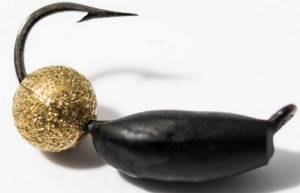
Experienced fishermen use “Nymphs”, which combine several colors - green and orange, white and red, black and orange, red and gray, white and black.
Hook
Another important component of the tackle is the hook. It serves to directly capture the catch, as well as to hang additional elements that attract the attention of the fish.
The “Nymph” hook must meet the following requirements:
- securely attached to the colored part of the tackle;
- be long enough for the awnings to move freely;
- have a smoothly curved and smooth neck that extends completely from the body of the jig;
- ensure rapid vertical movement of the bait due to the ear bent at an angle of 25–40°;
- have a sharp end that helps you quickly catch fish.
Dimensions
Since the nymphs of different insects are not the same size, the size of the bait may vary. On average, the length of the tackle is from 0.4 to 1.5 cm. The jig should be small, otherwise it will lose its resemblance to a real insect and will not bring a catch.

The size of the “Nymph” is determined depending on the depth of the reservoir - the deeper it is, the larger the bait should be. Small jigs are used in shallow reservoirs, as well as during fishing during the dead of winter.
Awnings
In nature, insect larvae have paws on their bodies, with the help of which they move through the water column. To ensure maximum similarity of the jig with the original nymph, additional elements are placed on the hook - canopies. When an angler starts playing with bait, these elements move with a characteristic sound (rustling, grinding), causing the illusion of a real insect moving in the water.
Basic recommendations for using awnings:
- all elements must move freely along the neck of the hook - otherwise they will not create the desired sound in the water;
- beads, small plates, beads are used as a canopy;
- when using flat parts, be sure to place a volumetric element (for example, a bead) between them - it will prevent the plates from “sticking together” under water.
Specialized stores sell “nymphs” that already have small hairs on their bodies. In this case, when immersed in water, the bait will make the necessary sounds even without canopies, so you don’t need to use them.
DIY jig nymph
A simple way to make a nymph from a piece of lead. There is no need to make molds and fill them; the only tools you will need are a hammer, a knife, a soldering iron and a file.
First of all, choose a suitable hook - with a long shank and a straight blade. Then bend it slightly in the area of the sting and tin it. Take a piece of lead and beat it on the anvil. Cut a piece of metal to the desired length. The tip of a hook mounted on a jig should be flush with the body of the bait or slightly extend beyond it.
Then make a longitudinal cut in the middle of the body of the future bait, insert a hook into it and solder it with lead. Give the body of the bait the desired shape using a knife or scalpel, and sharpen it with a file or needle file. All that remains is to paint the bait - and the reelless nymph is ready.
Catchable jigs for crucian carp
Crucian carp, although it is a fish that is unpretentious to food, in winter, due to the lack of vegetation, feeds on animal food: worms, insect larvae, small crustaceans living in bottom silt or sand. Therefore, most often in winter it is caught with ordinary jigs using bloodworms, caddis fly larvae, rhine moths, etc. However, some fishermen also practice catching crucian carp with a jigless bait.
For this type of fishing, weighted baits are used, mainly made of tungsten with a diameter of 0.1-0.17 mm. Specialized jigs for crucian carp in most cases have a red or orange body, but other colors should not be neglected.
Considering that in winter this fish leads a bottom lifestyle, it needs to be caught at maximum depth. And the greater the distance to the bottom, the brighter the jig should be. The best reelers for crucian carp are “Uralka”, “bug”, “ant”, “goat”.
How to make a jig with a crown
To make such a jig, you will need a nut and a bearing ball, as well as copper or brass foil:
- Burn the foil over a candle until it turns blue.
- Then place it on the nut and press it with a ball to make a depression in it, tap the ball with a hammer.
- Trim off excess foil.
- Use a sewing needle to make a hole in the center of the crown.
- Clean the edges of the workpiece with a file.
- Place the crown on the pin, insert it into a wooden block, place the hook and fill the future jig with solder.
- Remove the workpiece from the pin and file all the irregularities, clean the hole for the fishing line.
- The finished jig can be painted or polished with felt and GOI paste.
- Using the same technology, you can make a jig from a rectangular piece of foil.
To give it the desired shape, bend it on a match. Next, as in the previous case, make a hole in the jig, put it on a pin, insert a hook and fill it with solder. During final processing, this rewinder must be given the shape of a semi-oval.
DIY cat eye jig
You can make such a reelless jig with your own hands from sheet lead. Cut a blank from it, slightly shorter in length than the shank of the hook.
Bend the lead in half around the shank of the hook and crimp. Fill the workpiece with solder and sharpen it with a file.
Cut a piece of silicone, put it on a needle and melt it over the fire.
Place a silicone ball on the hook of the rewinder.
Instead of silicone, beads can be used to make such a jig.
You can make a jig for carnations in the same way. In this case, you need to put a bead (beads) on the forend of the rewinder.
How to make a witch
To make a witch you will need:
- olive sinker weighing 2.5 g;
- hacksaw;
- file;
- wire;
- three hooks;
- 8–10 multi-colored beads;
- black paint.
Clamp the olive in a vice and cut it in half. After this, process the workpiece so that there are no sharp corners left on it. And also, ideally, it should not shine.
The next step is to clamp half of the olive in a vice and make a longitudinal cut on it, but not all the way. Use a hacksaw to make a notch around the perimeter of the olive, 2–3 mm from the top.
Fold a piece of wire in half and twist it.
Insert the wire into the hole of the olive so that the loop is on top. Squeeze the olive with pliers so that the longitudinal slit previously sawn on the olive closes.
Paint the sinker and wire black.
Cut the wire coming out from the bottom of the olive. In this case, leave the ends about 3 mm long and bend them.
Place 2-3 beads on each hook and place them on the wire. Wrap the wire around the body of the bait along the notch that you sawed earlier. Twist and pull the ends of the wire together. Do not overtighten it; the hooks should move freely.
Fishing technique
When using a jig without bait, you need to master a certain technique for guiding it (playing it). Without this, even the most attractive and expensive mothless machine will turn out to be just a piece of metal.
Experienced fishermen know dozens of different types of fishing, but for a beginner it will be enough to master a few simple techniques.
- The bait is lowered to the bottom, struck several times on its surface, and then raised with low-amplitude twitches to a height of 20-30 cm. After this, the process is repeated.
- The jig is immersed to the bottom, held for a few seconds, after which they begin to slowly lift it, stopping for 1-2 seconds every 10-15 cm.
- The reelless fish submerged to the bottom is smoothly lifted, making small horizontal jerks with the fishing rod.
DIY devil
Another original mothless, which is even more popular than the witch. It is made on the basis of a tee. The devil has a vertical, elongated body.
You can take a ready-made tee or make it yourself from singles. If you choose the second option, put three hooks together, after biting off the ears of two of them, and tie them together with wire. You can also put a bead on the hooks. Insert the structure into the drill chuck, solder it, and the tee is ready.
Then solder first one piece of lead to the hook, then the other.
Trim off the excess and process the bait with a file and needle file.
Paint the finished bait; most often black is used for devils. This bait should be in every fisherman's arsenal.
Modernization of purchased mothless machines
The production of reelless jigs can be supplemented by upgrading purchased baits. Refining them will eliminate the shortcomings and make them more catchable.
If a tungsten jig is equipped with a low-quality hook, it can be replaced. This happens rarely, but sometimes it does happen. The hooks are soldered to tungsten with tin alloys, so they can be replaced with high-quality ones using a soldering iron. This cannot be done with a lead or tin jig.
Another option is to modify the rewinder with a file or needle file to change its shape, and therefore the nature of the game. The simplest option is to make a flat on a drop-shaped jig.
The next way to improve a purchased rewinder is to insert a rubber casing into its hole. Thanks to it, the edges of the bait's body will not cut the fishing line.
Another option is to paint the bait any color you like by applying paint to it or dipping your jig into it. The main thing is to choose a coloring material with good adhesion to the metal and first degrease the mopless paint.
Rewinder equipment
To give purchased and homemade reelless jigs a more attractive look to fish, they should be decorated with additional elements.
Beads
Most often, when retrofitting a bait, several multi-colored beads are put on the hook, and then a piece of rubber or silicone cambric so that they do not fly off. With beads, the jig becomes visually more attractive to fish. They also knock against each other and on the shank of the hook.
The fish perceives this noise, and it arouses additional interest in it. In order for the beads to work well, they must be chosen correctly in size - they must sit quite loosely on the shank of the hook.
The best color combinations to use:
- for perch: yellow in combination with any color;
- for roach – green and white, red and white;
- for bream - white and blue, black and yellow;
- for dace and bleak – black and yellow.
Colored cambrics
Instead of beads, you can put multi-colored short pieces of cambric on the hook of a rewinder. They will give the bait an attractive appearance. At the same time, they will not make a knock, so cambrics are inferior to beads in efficiency.
Pendants
Another option is to use pendants. You can put a piece of chain of 3-5 links on the fore-end. It also needs to be secured with a cambric so that it does not fly off. When playing with bait, the chain hangs motionless on the jig. However, it attracts fish.
The disadvantage of such a suspension is that sometimes it overlaps and covers the tip of the hook, as a result of which it is not possible to hook a fish. In the cold, metal links quickly set. Therefore, after moving from hole to hole, the ice on the chain must be melted before lowering the bait into the water.
Beads are also used as pendants. It is attached to a fishing line. In this case, the stop cambric is placed near the tip itself so that the bead pendant has maximum free movement.
Nozzleless jigs. Types, description
- VK
When the time comes for active ice fishing, anglers rush to replenish their stocks with new models of baitless jigs. Many winter fishing enthusiasts prefer to make their own baits and achieve excellent results in this field. But making a catchy bait is only half the battle; it also needs to be presented correctly.
Simple jig "Devil"
Jig "Devil" simple weight - from 0.3 g. The most common type of jig with three hooks. Suitable for catching large roach, bream and other fish. A larger jig (from 1.5 g and above) is a good pike perch bait.
Mormyshka "Devil" compound
Jig "Devil" composite weight - from 0.8 g. Works well in strong currents and great depths when hunting for large fish (bream, ide).
Jig "Devil" curved
Curved jig "Devil" weight - from 0.5 g. It has a more varied game than the classic bait. Shows its best qualities most effectively in weak currents.
Mormyshka "Mini-Devil"
The “Mini-Devil” jig weighs 0.2-0.3 g. Thanks to its low weight and modest size, it attracts the attention of fish quite well, even if it is simply raised or lowered in the water column at a minimum speed. Unlike larger “devils”, “mini” ones can be used to catch small roach and perch in the coastal zone. A small piece of lead, equipped with three hooks, can help out an angler even during the most unstable bite.
Mormyshka "Twisted"
Mormyshka "Twisted" weight - 0.1-0.15 g. This ultra-light bait is especially good for catching medium-sized perch in shallow areas of low-flowing reservoirs.
Mormyshka "Bedbug"
Jig "Bedbug" weight - from 0.5 g. The bream jig works most effectively in the bottom layer. Low-frequency bait (60-80 vibrations per second) makes complex oscillatory movements in horizontal and vertical planes. It is used in standing and low-flowing reservoirs at great depths.
Jig "Medusa"
Jig "Medusa" weight - 0.3-0.6 g. Imitates the behavior of an aquatic organism, smoothly moving its legs. Fishing objects: perch, roach, bream, etc. Used in currents and in still water. The measured, quivering movements of the bait attract perch and large roach. Retrieving pace: smooth rise and fall with a small amplitude of nod oscillations.
Mormyshka "Tenka"
Jig "Tenka" is a large jig (1.5-2 g), more like a spoon, designed for catching perch, ide, large roach (on the last ice). Used in weak currents and standing water. “Tenka” is played like a regular jig, with a frequency of two to three vibrations per second and with increased amplitude. After three or four retrieves, it is useful to make one or two strokes, working the bait like a spinner.
Mormyshka "Cobra"
Jig "Cobra" for perch and ide; weight -0.5-0.8 g. Wiring - energetic “sawing” with fast vertical movements.
Mormyshka "Goat"
The Goat jig is a very common bait; weight - 0.3-0.8 g or more. Suitable for most winter active fish. The body of the bait in most models has a smooth bend. The inside of the “goat” is in most cases made of copper or brass foil and polished to a shine. The outer surface of the body is painted black or dark green. With correctly selected wiring, the game of the “goat” resembles the movements of an amphipod. This technique is effective: a fairly heavy jig crashes into the ground and begins to vibrate quickly, then with an amplitude of 34 mm it comes off the ground and begins to rise. The wiring speed can be either medium or fast.
Movable jig "Goat"
The “Goat” jig has a moving mass of 0.5 g. It has a more varied game. An additional game element in the form of large beads increases the chances of catching a “white” fish.
Mormyshka "Chain"
The “Chain” jig is a classic no-attachment jig. Its shape and size are selected in such a way that during wiring it produces the highest vibration frequency (over 200). This requires the fisherman to have certain qualifications. The bait, vibrating at a high frequency, is slowly and smoothly raised to a distance of 1 m or more from the bottom, then lowered in the same way. Very often bites occur at the top point of the rise. It is recommended to sometimes slow down the rate of oscillation of the jig, resuming the previous rhythm after 7-10 seconds. This technique often leads to success. Large perch (“humpbackfish”) are especially partial to the “chain,” but in the middle of winter they are half asleep. It is quite difficult to get him to try the bait; sometimes you have to sit over the hole for at least 15-20 minutes.
Mormyshka "Boat"
The “Boat” jig is used at depths of up to 2.5 m and works most effectively in shallow water. Weight - 0.3 g. More than half of the body volume of the jig is occupied by polymer material. Fishing objects: perch, roach, bream and other fish. The bait is balanced so that it works equally effectively with any fishing method. Swaying lazily as it rises slowly, it will attract wary roaches. With more intense fishing, it will have an irresistible effect on large perch and ide. A high oscillation frequency is a prerequisite for the successful use of most nozzle-less jigs. The “boat” allows you to reduce the oscillation frequency to minimum values without loss of catchability. This is very important, since not all anglers can maintain a high retrieve rate. The fish takes this jig boldly, mistaking it for live food. Due to its design features, the bait creates vibrations very similar to vibrations emanating from a real aquatic organism.
Flat jig "ant"
Flat jig "ant" weight - from 0.3 g. This modification of the classic "ant" has a more varied play pattern.
Mormyshka "Donkey"
Jig "Donkey" weight - 0.5 g. Used in currents and in standing water. Fishing objects: perch, roach, bream and other fish. The soft dark gray color of the lead alloy does not alarm finicky underwater inhabitants (which is especially important in “overfished” reservoirs). Deep “grooves” on the “back” create an interesting effect: when reeling, the jig makes noise, attracting fish from afar. The bait works quite successfully in gentle currents; the fishing is carried out near the bottom. Using the force of the current, tapping the bottom in small “steps”, the jig can be forced to move further and further away from the hole. Thus, a significant bottom area of the reservoir is fished, which significantly affects the catch. “Scratching” along the bottom and raising clouds of turbidity, the “donkey” provokes both pike perch and bream to bite.
Mormyshka "Ant"
Mormyshka "Ant" weight - from 0.4 g. It is possible to successfully catch the "ant" in large reservoirs. Before the flood, roaches begin to concentrate at the mouths of rivers flowing into the reservoir. The movement of the roach takes on a massive character, and it begins to move upstream of the river. Having encountered an “ant” with a black body and a white bead as a bait on its way, a large roach greedily grabs this “decoy.”
Mormyshka "Motylevaya"
Mormyshka "Motyleva" weight - 0.15-0.2 g. Ultra-light shallow-water bait with an elongated hook shank. The main working element of the bait in this case is a plastic bloodworm. The wave-like vibrations of the silicone tip of the imitation bloodworm, mounted on the hook of the jig, have a favorable effect on the bite. A medium-sized fish swallows the bait with great pleasure. Small roach pays increased attention to the oscillating silicone tail, pulling the plastic bait off the hook, which causes many empty hooks.
Mormyshka "Moth"
The moth jig has a low mass (0.1 g) and is used in the smallest places. Thanks to its segmented body, the bait resembles a large bloodworm. When fishing for perch, the “moth” is used at a hard, aggressive pace. Sometimes the perch bites sluggishly on a jig with a bait, while at the same time the bites on a “moth” are more decisive. Retrieving is carried out by lifting the jig up to the very edge of the ice, then slowly lowering the bait to the bottom, and the process is repeated. Sometimes, especially on frosty days, the activity of the perch increases, and it boldly swallows the “moth”, and the nod detects a sharp bite, as if on a spinner.
Mormyshka "Drobinka"
The “Drobinka” jig is articulated, weighing from 0.3 g or more. Quite a universal bait. Depending on the performance, it actively plays at different depths and attracts a variety of fish.
Jig with beads
Jig with beads at shallow depths and in the absence of current, some fishermen use a tungsten jig of a streamlined shape, weighing 0.2 g, equipping it with two relatively large plastic beads. The bait does not look very presentable, but it is catchy. Yellow and white colors of plastic baits attract roaches well. The game of this “reelless” jig is significantly influenced by the movements of the beads, which to some extent compensates for the intermittent movements of the jig itself. The body of the bait, as it were, sets the main tone of the game, “swinging” the voluminous but light baits.
Jig "Ant" tungsten
Tungsten jig "Ant" weight - up to 0.6 g. Used at significant depths. Thanks to the low frontal resistance, it can work stably in medium-force currents. Effectively used when fishing for bream, ide, large perch in holes with weak currents adjacent to river islands.
Mormyshka "Fly"
The “Fly” jig weighs 0.5 g. A hook No. 3 with a slight overlay in the fore-end area is soldered to a copper or silver-plated polished crown. Fishing objects: perch, medium-sized roach (along the first ice). During an accelerated rise, the jig moves away from the hole, and the excited perch willingly grabs the shiny “fly”. Sometimes the “fly” is jerked sharply several times, as a result of which it makes wide circular movements. If you return to normal fishing after this, you can provoke another apathetic perch to bite.
Ant jig "goat"
Ant “goat” jig weighs 0.15-0.17 g. This unique symbiosis of two designs has proven itself to be excellent when catching active roach and perch. The jig has a curved cut located in the upper part of the body.
Mormyshka lead body of an “ant”
Jig - the lead body of the “ant” consists of three segments arranged in an arcuate manner; weight - 0.15 g. The largest segment has a flat cut. This feature allows the jig to make additional vibrations in the horizontal plane. The game is more lively than that of an ordinary “ant” and has an excellent effect on the catch.
Mormyshka "Donnaya"
The “Bottom” jig weighs 0.2 g. The weight of the “reelless” jig is made in the form of a disk with a flat bottom. A hook with a plastic imitation of a bloodworm is movably attached to the eye of the jig body. “Bezmotylka” is designed for fishing in the bottom layers of water. If the jig begins to hit the bottom, nearby fish watch what is happening with interest. When the “bottom fish” slowly emerges from the cloud of rising turbidity, it immediately finds itself in the mouth of a curious perch. The jig is not raised above 5-7 cm. In addition to roach and perch, it is good for catching bream in gentle currents. The movable hook is fully equipped to meet fish from different directions. In large lakes, towards the end of winter, the stomachs of large perches are filled with black bugs. For a reason unknown to me, water insects accumulate under the ice in large quantities. Perches, having discovered an accumulation of easily accessible food, radically rearrange their diet.
Lightweight tin jig
A light tin jig (weight - 0.15 g) shows a phenomenal result in such conditions. With sharp swings with an amplitude of 57 cm, the “rewinder” makes throws in the horizontal plane, reminiscent of the movements of a small bug. The perches present nearby do not ignore the daring behavior of the small “insect”.
Mormyshka "Cone"
Jig "Cone" lead jig; weight - 0.15 g. Well-balanced design responds equally well to different wiring rates. Large beads have a noticeable effect on the movements of the bait. The “cone” is universal; you can use it to conduct reconnaissance in an unfamiliar body of water.
Mormyshka "Lentil" made of plexiglass
The “Lentil” jig made of plexiglass is placed on a separate leash 5-10 cm above the main bait. Works in tandem with the “devil” or any other “mothless”. Due to its small mass (less than 0.1 g), the fish easily draws it into its mouth and on some days more than half of the bites occur on the “lentil”.
Mormyshka "Malek"
Jig "Malek" is a large lead jig (weight - 0.6-0.9 g) for river fishing. Features of the package: a strip of white goat hair is glued to the back of the bait. A section of a river with a moderate current is examined using the method of stepwise wiring, floating a jig downstream. Fishing objects: pike perch and large perch.
Brass jig "bug"
Brass jig "bug" (weight - 0.3-0.5 g) on pebble river riffles. Fishing becomes especially successful when you manage to find a small pit located behind a decent boulder.
Mormyshka "Pendant"
The “Pendant” jig is an almost weightless design consisting of a hook No. 3.5 and soft plastic balls. Used in combination with a heavier lower jig (“devil” or “goat”). It is great for catching almost any available fish.
Mormyshka "Strelka"
Jig "Strelka" weight - 0.2 g. A fly with three tail tassels is tied to the shank of the hook. “Strelka” performed well on a rocky bottom in places with weak currents. It happens that the bait knocks on some overgrown stone located directly under the hole. In such a situation, bites follow one after another. The “arrow” sliding along the hard slope of an underwater obstacle resembles the movements of a natural prototype (dragonfly larva).
Jig "Bormash"
The Bormash jig is similar to a crustacean that lives under the boulders of river rapids. "Bormash" is effective in closed reservoirs, backwaters and reservoirs. Allows low-frequency wiring (90-100 vibrations per second). A synthetic tape is wound around the lead body of the jig. The fish reacted very favorably to such an innovation. "Bormash" has proven itself well when catching perch, roach and bream.
Mormyshka "Caterpillar"
Jig "Caterpillar" weight - 0.3 g. Lead wire is wound onto a hook No. 3.5 with an elongated shank; the interturn space is filled with squirrel fur fibers. As a result, the “caterpillar” makes smooth, slow oscillations during the drive, which cause confident bites from roach and bream. However, due to the increased resistance of the aquatic environment, immersion at the starting point of the wiring occurs slowly, so the “caterpillar” is effective mainly at small and medium depths.
Hanging hook
The advantage with a hanging hook is the high mobility of the main attracting element. During periods of increased feeding activity, perch eagerly grabs a hook wagging in all directions with baits strung on it.
Related articles:
Winter whitefish fishing
Guards and nods for winter fishing rods
Review of winter tents
Catching pike on a balance beam
